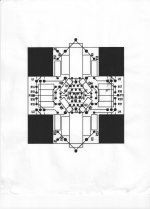I personally have to add, "Procrastinate" 😀
It just might be your understanding of English and what "Think" really means!
"Test and measure, guys. Words tend to be empty"
I did. It was over 20 years. I think physics has stayed the same though.
;-)
I did. It was over 20 years. I think physics has stayed the same though.
;-)
These are good sounding transformers and noticeably (audibly) lower noise. If you’re into that sort of thing.What we used. I hope it explains a few points.
One other point of interest, the single primary version sounds better than the dual... Actually I have found this to be generally true, not just this model.What we used. I hope it explains a few points.
It just might be your understanding of English and what "Think" really means!
My understanding of this word is, when I am thinking too long and can't stop on some decision. 😀
😱 Wow!
Square, cross, triangles, points, crystal shape... Even resistors form something like circle representing Organic Nature?
No doubt it should attract best Thin Energies! 😉
It looks like an Ancient Temple. How long did you work on such beauty?
Square, cross, triangles, points, crystal shape... Even resistors form something like circle representing Organic Nature?
No doubt it should attract best Thin Energies! 😉
It looks like an Ancient Temple. How long did you work on such beauty?
My contribution: I hope that it answers a few questions. It is not the complete CTC Blowtorch power supply, but it is close enough for discussion.
It is always interesting to note that some Japanese manufacturers used a similar but not identical set up in their cheaper slim profile integrateds. Bando and similar had them in the catalogs,as low profile units, but single winding. And so... the manufacturers used them, as they used a pair...and ended up with some surprisingly hefty little units, with a notably high VA PS. And how good some of those amps ended up sounding, for a marginally built piece of gear. Too bad they used them for both channels. Ah well, can't have everything.
Here's a spool of braid over the core wires...the bass shakers are to precondition the electrons within the grain boundaries..
j
Uh-oh!
John has KBK bait laid out at the end of a long line.
The fish peers at it.
Should he bite?
Uh-oh!
John has KBK bait laid out at the end of a long line.
The fish peers at it.
Should he bite?
😀
Hey, they use vibration to anneal large weldments, why not copper??
I'm just not sure if 4 aura shakers mounted to the plate is sufficient to force quantum tunneling through the boundaries..😕
Ok arthur..
j
It is that way to draw in the magic crystal energy from the astral plane. '-)
I thought that was what brilliant pebbles were for, did Geoff Kait consult on the layout?
BTW does anyone listen to their amps on batteries to compare to the power supply? I figure 10 SLA's could do a 100W amp. I can see it now all wired up with 4/0 welding cable.
I thought that was what brilliant pebbles were for, did Geoff Kait consult on the layout?
BTW does anyone listen to their amps on batteries to compare to the power supply? I figure 10 SLA's could do a 100W amp. I can see it now all wired up with 4/0 welding cable.
Actually every so often we do a small reinforcement system that uses batteries instead of generators.
There is a big difference, but it is also an entirely different environment.
I almost prepared 24V powered class D amps and battery chargers for festival of bards on campground, but realized that I can't participate this summer... Last times I participated there was 90V without load instead of 120, less under the load.
More seriously, form follows function. The basic layout shown in the last drawing IS the fundamental circuit path of the audio signal that flows through the CTC Blowtorch.
The layout looks almost like the schematic. This is the IDEAL approach.
Lately, due to space and added function considerations, some of my newest layouts, made by the same designer, Carl Thompson, of CTC are NOT as symmetrical, and get VERY confusing when we try to troubleshoot.
I prefer layout following the schematic, and will insist on it, in future designs.
The layout looks almost like the schematic. This is the IDEAL approach.
Lately, due to space and added function considerations, some of my newest layouts, made by the same designer, Carl Thompson, of CTC are NOT as symmetrical, and get VERY confusing when we try to troubleshoot.
I prefer layout following the schematic, and will insist on it, in future designs.
VERY confusing when we try to troubleshoot.
If such tries are needed then it wasnt correctly designed
or built at the first place....
- Status
- Not open for further replies.
- Home
- Member Areas
- The Lounge
- John Curl's Blowtorch preamplifier part II
